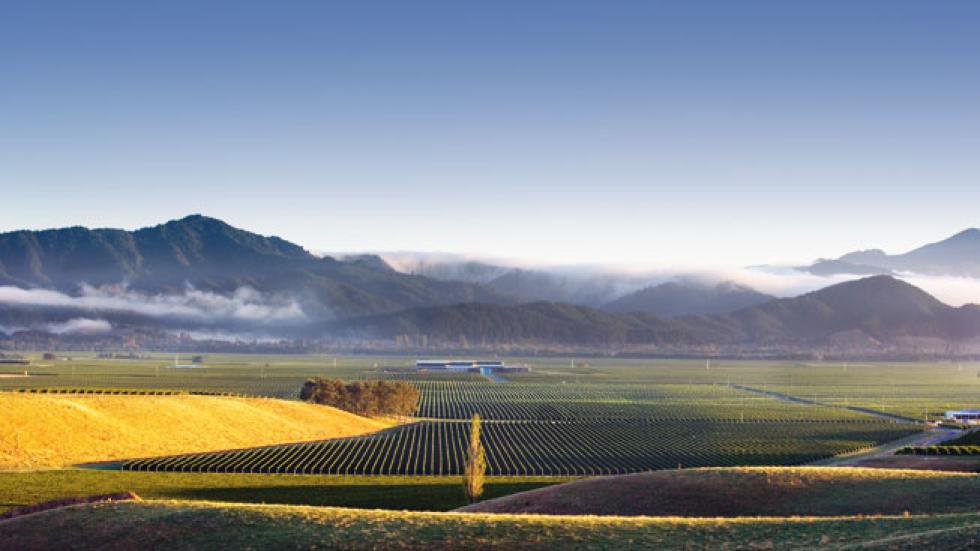In general, I think it’s safe to say that to like New Zealand sauvignon blanc, it doesn’t hurt to have a taste for grapefruit juice.
I don’t mean the sweet, pink stuff, but real grapefruit juice, squeezed from tangy, sour white fruit, grown on ancient trees like the one in our backyard in Tampa. It produced gallons of liquid gold, great for salty dogs, a vodka drink designed to slake the heat, served over lots of ice in tall, salt-rimmed glasses that you could rub against your temples when the heat and humidity hung together in the 90s.
That’s what I think of when I take a first sip of most New Zealand sauvignon blanc, particularly Oyster Bay with its fragrance of pinched grapefruit rind, crisp, refreshing taste and smooth, dry finish. It’s an excellent drink for our warm, or even cool, New England summer evenings, and a great match with appetizers, fish or fowl.
I first discovered Oyster Bay a couple of years ago during a week-long family reunion on Peaks Island, 20 minutes by ferry off Portland, Maine. We had brought wine with us, but, as things often go during family reunions, we had underestimated the demand of our nightly sessions, and the supply proved to be inadequate, leaving us the options of going to the mainland or making a visit to the island’s small, but adequate, store.
The store had a decent wine selection, albeit limited, and the sauvignon blanc choice was, fortunately, Oyster Bay. I’ve been a fan since then. Although the price can creep out of our range — it tops out at $15 — I often find it for $10 to $12 and buy it whenever I do, particularly in the summer.
The Oyster Bay line of wines is produced by Delegat, a large company, still controlled by a New Zealand family, with a goal of becoming one of the world’s “truly great super-premium” winemakers, the firm’s website says. The company also produces a line under the Delegat name, but I haven’t run across them yet.
According to its annual report, Delegat sold about 425,000 cases of wine in North America last year and, as a result of winery expansions, is on target to double the amount this year with worldwide sales of better than 2 million cases and a 9 percent growth in profits of about $40 million.
The company uses the latest winemaking technology and touts its sustainable and energy-saving agricultural practices, such as rarely tapping the aquifer for irrigation, instead recycling rainwater from the specially designed roof of its winery.
Oyster Bay sauvignon blanc takes its name from a bay that borders the vineyard. The wine is produced from grapes grown in New Zealand’s Wairau Valley on the tip of South Island in Marlborough, the country’s top wine growing region. The area’s growing season is September to April, a period of hot and dry weather when temperatures can range as much as 50 degrees between the heat of the days and coolness of the nights, resulting in intensely aromatic and flavorful wines, such as the Oyster Bay sauvignon blanc.
In fact, this wine is so grapefruity that I can almost imagine using it in a perfect salty dog; just add a little ice, vodka and salt. Actually, I wouldn’t recommend adding anything. Just serve it cold. It will handle the rest on its own.
Those of you who hate grapefruit, don’t despair. Oyster Bay also produces a Chardonnay, and the company makes what I understand is very good pinot noir and merlot, but I haven’t tried them. There really are too many good and exciting wines on the market to get around to all of them in a timely fashion.
And anyone who likes sauvignon blanc that’s a little less intense with more lemon flavors, try something from Chile and perhaps California.
Oyster Bay sauvignon blanc is widely available in the Pioneer Valley. I’ve been finding it in the $10 range, which is a terrific bargain.
Suggestions of wines in the $10 range that are available in the Pioneer Valley are always welcome. Warren Johnston can be reached at warren.nelson.johnston@gmail.com.






